Note: There is always an exception to every rule.
Overview
Road type designations in Waze should be determined by the physical layout and use of the road, not by the name of a road.
Road types do not affect naming. A dirt road that is a US Highway would still be named as “US Hwy #.” See Road Naming (USA)
Some road type classifications are influenced by city size, traffic density, and regional conventions. For example, in a very large city a primary street may have three or more lanes in each direction on a divided road. While in a town of dirt roads, the only paved single lane street could be a primary street.
While editing the maps, you may notice that some of the roads are not labeled properly. This means, the road type might be wrong (a highway is marked as a street) or that one road has a few road types (a highway is marked as Freeway, highway and primary at different segments).
The importance of proper labeling is in two aspects:
- When viewing the map, the 'bigger' roads should appear at the far zoom levels. Without proper labels, the 'zoomed out' display can be very confusing.
- When planning a route, major roads will get priority over smaller roads.
Starting Point
Naming conventions can be useful as starting point when determining a road type. Be aware that there are many regional naming variations. Remember that this is only guide on where to start when determining a road type.
- Interstate ~ Freeway

- US Hwy ~ Major Highway

- State Hwy ~ Minor Highway

- County Road ~ Primary Street.

- City street ~ Street.

- Exit ~ Ramp

- Unnamed ~ Parking Lot Road

Road Type Classifications:
Freeway 

Although it is currently listed under Highways, a freeway does not have to be a highway.
Freeways have strict classification rules.
- Almost all US Interstates are Freeways (exceptions Wikipedia Link)
- Multi-Lane, divided road (with rare exceptions Wikipedia link)
- No cross traffic.
- No stop lights (except for ramp meters).
- No stop signs.
- No parking.
- No stopping (except for toll booths, freeway access metering, movable briges Wikipedia link, and traffic congestion.)
- Highest speed limits. (relative to region)
- Some have minimum speed limits.
- Limited access
- Access restrictions vary by state but some typical restrictions are
- No pedestrians
- No bicycles
- No mopeds
- Entrance ramps are typically designed with an acceleration zone so that cars can accelerate up to freeway speeds before merging into freeway traffic.
- Exit ramps are typically designed with a deceleration zone so that traffic can exit the freeway at freeway speeds without obstructing traffic, then have sufficient distance to slow down before any turns.
- Access restrictions vary by state but some typical restrictions are
Highways

Highways are typically numbered or named roads that can be followed to get from one city to another. If the cities are in different states, it will likely be named as a US highway. If they are in the same state, it will likely be named as a State Highway. If they are in the same county, they may be named as a County Highway. There are two main Highway labels in Waze, Major and Minor. Their use may depend on regional population or traffic densities.
One differentiation between Major and Minor is the design and use of the road. A Major Highway is purpose built for the expedience of thru traffic. A Minor Highway could have a diverse range of priority placed on the flow of thru traffic.
- US Highways should typically have a Major Highway or Minor Highway road type.
- State Highways differ by region. In some states all State Highways deserve a Highway road type. In others the “State Highway” term is used very loosely, or every road in a town may have a state highway namel. In those cases many state highways will not be a highway road type.
- County Highways vary greatly, some may deserve a highway designation.
Major Highway

Purposely built as a major throughway.
- Higher speeds. Speed limits should be near or equal to Interstate or Freeway speed limits in the same area. (typically within 5-10mph)
- Multiple lanes in each direction.
- Separated directions of travel.
- Turning traffic is typically limited to specified turn lanes or freeway style ramps to minimize obstructions to thru traffic.
- Partially limited access with few minor streets intersecting with this road. Intersections are most often with primary roads or other highways.
- Can have stoplights or freeway style interchanges.
- No stop signs
- Pedestrian crossings may be limited.
- Local business access is often restricted to frontage roads or other streets.
Typically roads with numerous side streets, parking lot accesses, residential driveways, low speed limits, undivided, or shared center turn lanes (suicide lanes) are not Major Highways.
Minor Highway

While still a labeled route that can be followed to get from one city/town/neighborhood to another, routing of thru traffic is not always a priority in the street design. Some minor highways are built with a higher priority on through traffic, while other minor highways are nothing more than a label dropped onto existing residential streets.
Minor Highways vary widely from large multi-lane roads with stoplights and higher speed limits, to small residential streets with stops signs.
Some minor highways may zigzag thru an area with many turns on local streets.
A Minor Highway thru the main street of a small town often retains focus on local access with pedestrian traffic and on street parking.
Ramps
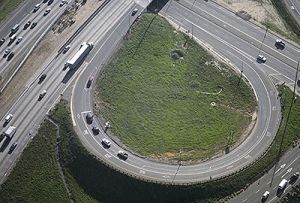

- All entrance or exits to freeways.
- A proper freeway style ramp onto or off of a Highway.
- A change of grade connector for any street type.
- Not for at grade street connectors.
- Not for turn lanes.
- Roads connecting a highway with a rest/service/parking area should be treated as ramps as well and named accordingly (e.g. "Exit to Service Area").
Streets


Usually for local travel within a town.
Primary Street

Major roads or boulevards used to get across a neighborhood or city.
- Usually given higher priority for right of way with traffic controls.
- Primary streets may have less residential driveways.
- A town’s “Main Street,” if it is not a highway, is typically a primary street.
- In some regions “County Roads” are typically primary streets.
A primary designation is very relative to population and traffic densities. In the smallest rural town, a primary street may barely be wide enough for two cars heading opposite directions to pass each other. In dense urban areas primary streets may need to be a divided road with multiple lanes of traffic in each direction having traffic controls at every intersection.
Service road

Also often known as a frontage road.
- A smaller street typically found running alongside a limited access highway or other primary street.
- Service roads allow local traffic to enter and exit driveways, parking lots, and intersecting streets without congesting thoroughfare traffic.
- (NOTE: Service Roads should NOT be confused with what is often called a "service alley". Service Roads will not prevent routing.)
Street

- Any road that traffic will be routed onto.
- At grade connectors & turn lanes when separated by enough distance from the streets that one is needed for proper GPS tracking.
Other
Dirt
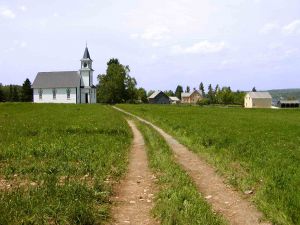
A road that is not paved
Parking Lot Road
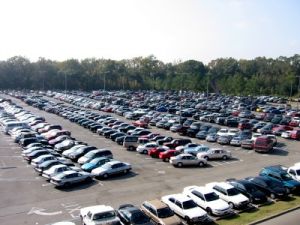
Parking lots, along with other publicly accessible roads such as alleys that should not be used for traffic routing unless directly at the start or end point of a route.
- Do not map the rows within parking lots because it clutters the map.
- With the current high penalty assigned to parking lot segments, Waze will do almost anything other than routing along a parking lot segment unless there is no other path at all. Using parking lot roads for ALL roads within a parking lot is not recommended as this will cause Waze to choose a route which has the least number of parking lot segments, which means it will also choose to go against turn restrictions from main roads.
- The current recommendation is to use a single parking lot segment for every location which connects to external streets and then use street type segments for all main drive segments within the parking lot itself. This reduces the penalties and Waze will choose better routes within parking lots and not go against turn restrictions. But because that single parking lot segment is there, Waze should not route through the parking lot to get to other destinations.
- Parking lot roads also provide the benefit of allowing turn restrictions to be properly set upon entry and exit of the parking lot. In addition, the proper use of parking lot roads can also help to avoid automated traffic jam reports as well as Papyrus Map Problems related to Wazers driving in unmapped parking lots. http://www.waze.com/forum/viewtopic.php?f=10&t=13825&start=20#p117202
Private Road
A private road that should not have any traffic routed along unless directly at the start or end point of a route. Some private roads may have gated or other controlled access points
Non-drivable
Your car should not be here!
- These may be useful for points of reference when navigating such as seeing on a map where a turn is in relation to a railroad crossing.
- When Waze users travel on a non-vehicle route such as a bicyclist or mass-transit rider, marking these routes can be useful to explain the GPS traces that result.
- If a base map scan has non-drivable routes on it, it is important to mark these to prevent traffic routing onto them.
- Non-drivable routes should not have any type of junction with a drivable road. When crossing a drivable road, the non-drivable road should be bridged across and set at a different level.
Walking Trails
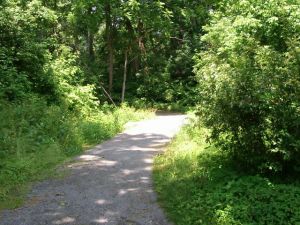
Also bike trails
Pedestrian Boardwalks

Stairway
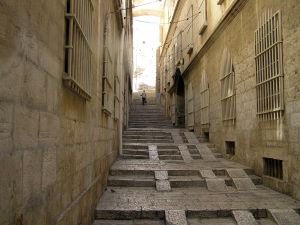
Railroad
Trains, Light Rail
Runway/Taxiway
For aircraft at airports
Types of segments (Roundabouts) 

Roundabouts have few principals:
The first one, each node on the roundabout can only be connected to no more than one segment.
Each connection has a spectrum that exists in order to notify the Client on how to define the message (Go straight, exit through the 2nd / 3rd / 4th exit).

Each connection has a spectrum that exists in order to notify the Client on how to define the message (Go straight, exit through the 2nd / 3rd / 4th exit).
The system will include the radius border from the center and notify the user accordingly.
